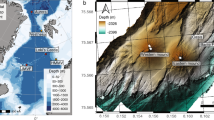Abstract
A new type of animal community has been found near hot vents in the subpolar Atlantic at 100 to 106 m depth off Kolbeinsey on the Jan-Mayen ridge. Incubation of high temperature fluids yielded cultures of undescribed hyperthermophilic eu- and archaebacteria, growing in a temperature range between 70° and 110°C depending on the isolates. Bacteria are closely related to species occurring within deep sea hydrothermal areas. In contrast to deep-sea vent sites of the Mid-Atlantic and other oceans, the Kolbeinsey macro- and meiofauna consists of species reported from non-vent areas in the boreal Atlantic and adjacent polar seas. The most abundant forms are a solitary hydroid polyp and two sponges. Kolbeinsey is an isolated and young area of hydrothermal activity at relatively low depth and in highly productive waters; these findings could indicate a model for an early evolutionary step towards the formation of a genuine specialized vent community.
Similar content being viewed by others
Literature cited
Banks, D. A. (1985). A fossil hydrothermal worm assemblage from the Tynagh lead-zinc deposit in Ireland. Nature, Lond. 313: 128–131
Grassle, J. E. (1985). Hydrothermal vent animals: distribution and biology. Science. N.Y. 229: 713–717
Grassle, J. F. (1986). The ecology of deep-sea hydrothermal vent communities. Adv. mar. Biol. 23: 301–362
Haymon, R. M., Koski, R. A., Sinclair, C. (1984). Fossils of hydrothermal vent worms from Cretaceous sulfide ores of the Samial Ophiolite, Oman. Science, N.Y. 223: 1407–1409
Hecker, B. (1985). Fauna from a cold sulfur-seep in the Gulf of Mexico: comparison with hydrothermal vent communities and evolutionary implications. In: Jones, M. L. (ed.) The hydrothermal vents of the Eastern Pacific: an Overview. Bull. biol. Soc. Wash. 6: 465–473
Hessler, R., Lonsdale, P., Hawkins, J. (1988). Patterns on the ocean floor. New Scient. 24 March: 47–51
Jensen, P. (1987). Differences in microhabitat, abundance, biomass and body size between oxybiotic and thiobiotic free-living marine nematodes. Oecologica 71: 564–567
Jones, M. L. (ed.) (1985). Hydrothermal vents of the Eastern Pacific: an Overview. Bull. biol. Soc. Wash. 6
Kennicutt, M. C., II, Brooks, J. M., Bidggare, R. R., Fay, R. R., Wade, T. L., McDonald, T. J. (1985). Vent-type taxa in a hydrocarbon seep region on the Louisiana slope. Nature, Lond. 317: 353
Lutz, R. A., Jablonski, D., Turner, R. D. (1984). Larval development and dispersal at deep-sea hydrothermal vents. Science, N.Y. 226: 1451–1454
Ocean Drilling Program (1986). Leg 106 Scientific Party: Mid-Atlantic bare rock drilling and hydrothermal vents. Nature, Lond. 321: 14–15
Paull, C. K., Jull, A. J. T., Toolin, L. J., Linick, T. (1985). Stable isotope evidence for chemosynthesis in an abyssal seep community. Nature, Lond. 317: 709
Rona, P. A., Klinkhammer, G., Nelsen, T. A., Trefry, J. H., Elderfield, H. (1986). Black smokers, massive sulphides and vent biota at the Mid-Atlantic Ridge. Nature, Lond. 321: 33–37
Saemundsson, K., Sigurdarson, S. (1987). Koleinsey. Aegir 80: 2–12
Southward, E. C. (1985). Vent communities in Atlantic too. Nature, Lond. 317: 673
Stein, J. L. (1984). Subtidal gastropods consume sulfur-oxidizing bacteria: Evidence from coastal hydrothermal vents. Science, N.Y. 223: 696–698
Suess, E., Carson, B., Ritger, S. D., Moore, J. C., Jones, M. L., Kulm, L. D., Cochrane, G. R. (1985). Biological communities at vent sites along the subduction zone off Oregon. In: Jones, M. L: (ed.) The hydrothermal vents of the Eastern Pacific: an overview. Bull. biol. Soc. Wash. 6: 475–484
Tunnicliffe, V. (1988). Biogeography and evolution of hydrothermal vent fauna in the eastern Pacific Ocean. Proc. R. Soc. Lond. (Ser. B) 233: 347–366
Tunnicliffe, V., Juniper, S. K., de Burgh, M. E. (1985). The hydrothermal vent community on Axial Seamount, Juan de Fuca Ridge. In: Jones, M. L. (ed.) The hydrothermal vents of the Eastern Pacific: an Overview. Bull. biol. Soc. Wash. 6: 453–464
Van Dover, C. L., Fry, B., Grassle, J. F., Humphris, S., Rona, P. A. (1988). Feeding biology of the shrimp Rimicaris exoculata at hydrothermal vents on the Mid-Atlantic Ridge. Mar. Biol. 98: 209–216
Wiessner, W. (1981). The family Beggiatoaceae. In: Starr, M. P., Stolp, H., Trüper, H. G., Balows, A., Schlegel, H. G. (eds.) The Prokaryotes. Springer Verlag, Berlin, Heidelberg, New York
Author information
Authors and Affiliations
Additional information
Communicated by O. Kinne, Oldendorf/Luhe
Rights and permissions
About this article
Cite this article
Fricke, H., Giere, O., Stetter, K. et al. Hydrothermal vent communities at the shallow subpolar Mid-Atlantic ridge. Marine Biology 102, 425–429 (1989). https://doi.org/10.1007/BF00428495
Accepted:
Issue Date:
DOI: https://doi.org/10.1007/BF00428495




